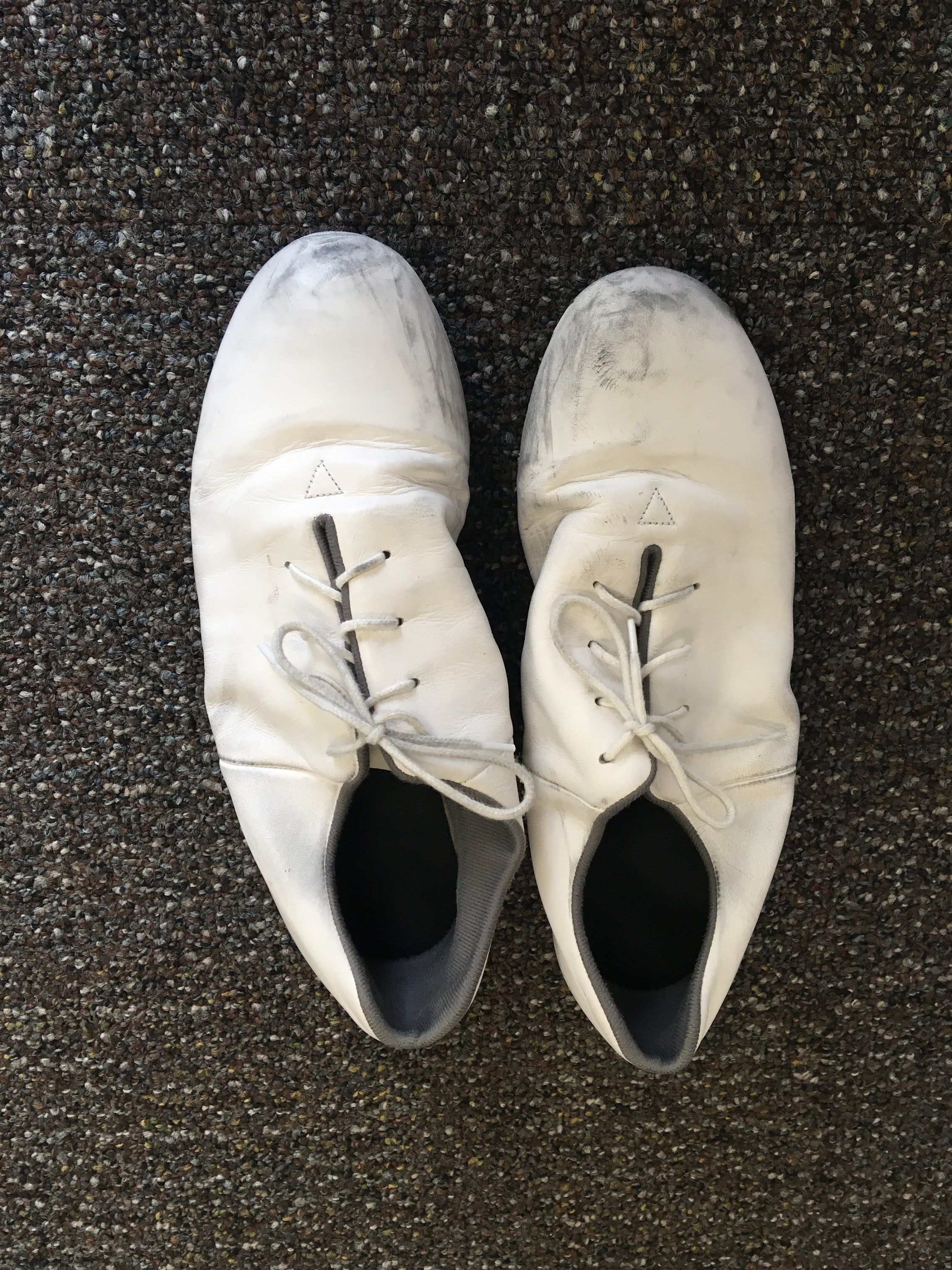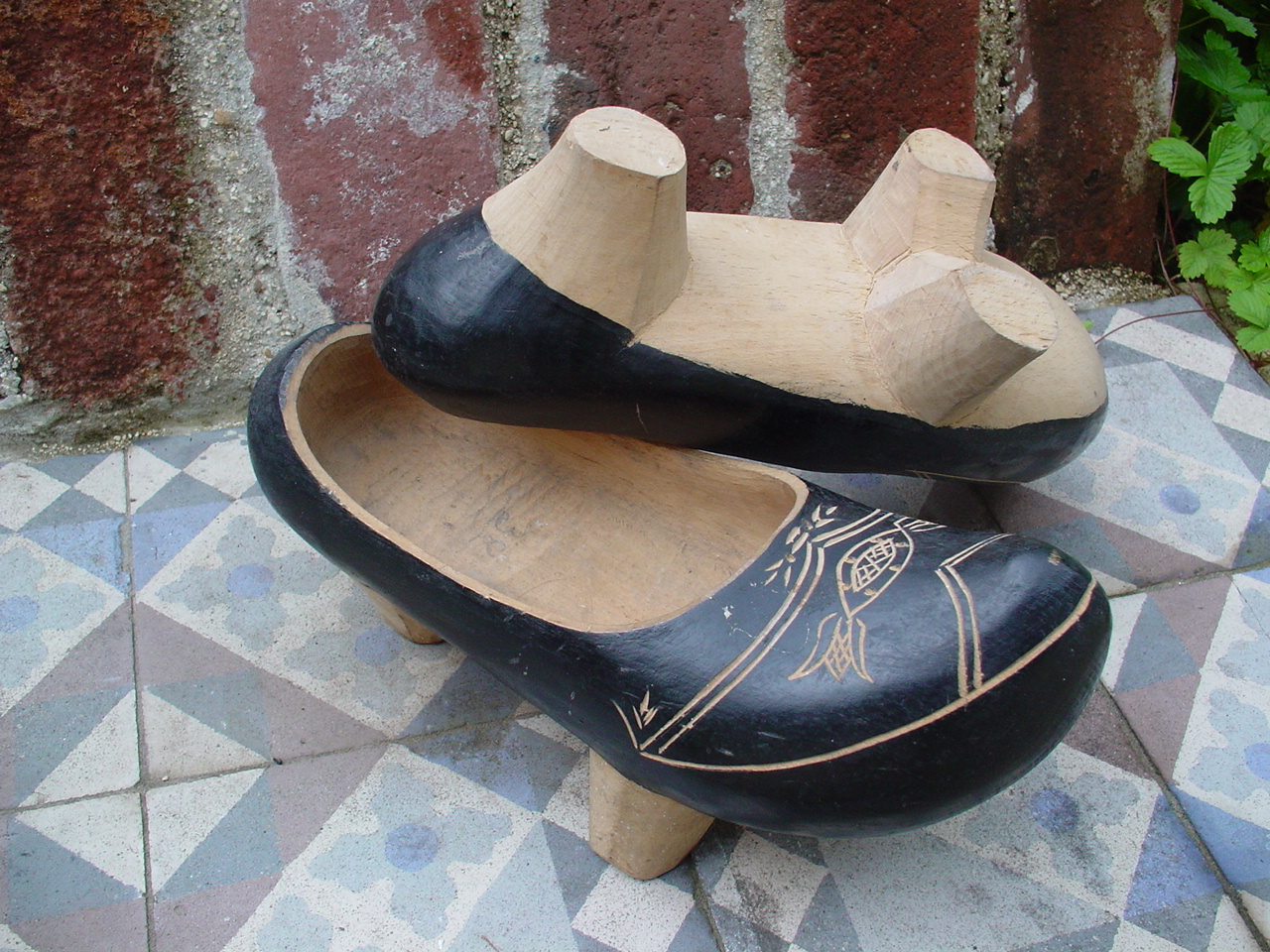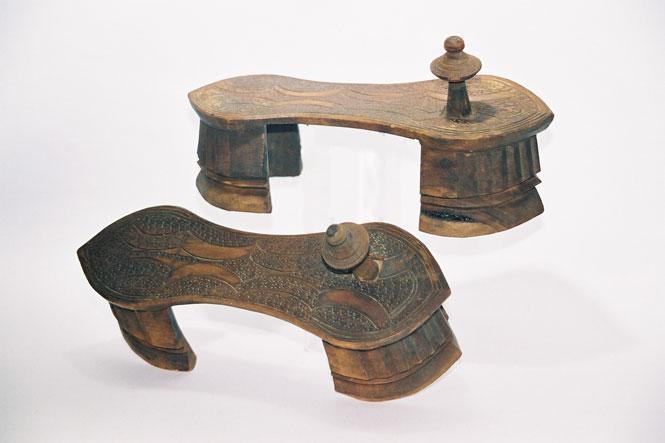|
Clog (other)
Clogs are a type of footwear that has a thick, rigid sole typically made of wood, although in American English, shoes with rigid soles made of other materials are also called clogs. Traditional clogs remain in use as protective footwear in agriculture and in some factories and mines. Although they are sometimes negatively associated with cheap and folkloric footwear of farmers and the working class, some types are considered fashion wear today, such as Swedish träskor or Japanese geta or even American crocs from Colorado . Clogs are also used in several different styles of dance, where an important feature is the sound they produce against the floor. Clog dancing is one of the fundamental roots of tap dancing, but with tap shoes the taps are free to click against each other and produce a different sound from clogs. Typology The ''Oxford English Dictionary'' defines a clog as a "thick piece of wood", and later as a "wooden soled overshoe" and a "shoe with a thick wood ... [...More Info...] [...Related Items...] OR: [Wikipedia] [Google] [Baidu] |
Klompen (Dutch Clogs), Wooden Shoes Museum In Drenthe
A klomp (plural klompen) is a whole-foot clog from the Netherlands. Along with tulips and windmills, they are strongly associated with the country and are considered to be a national symbol of the Netherlands. Usage Approximately three million pairs of klompen are made each year. They are sold throughout the Netherlands. A large part of the market is for tourist souvenirs, though some Dutch people, particularly Agriculture, farmers and Greenhouse#Netherlands, market gardeners, still wear them for everyday use. Outside the tourist industry, klompen can be found in local tool shops, local tourist shops and Garden centre, garden centers. The traditional all-wooden Dutch clogs have been officially accredited as safety shoes with the CE mark and can withstand almost any penetration including sharp objects and concentrated acids. They are actually safer than steel-capped protective shoes in some circumstances, as the wood cracks rather than dents in extreme accidents, allowing easy re ... [...More Info...] [...Related Items...] OR: [Wikipedia] [Google] [Baidu] |
Clogging
Clogging is a type of folk dance practiced in the United States, in which the dancer's footwear is used percussively by striking the heel, the toe, or both against a floor or each other to create audible rhythms, usually to the downbeat with the heel keeping the rhythm. Clogging is the official state dance of Kentucky and North Carolina. Description In later periods, it was not always called "clogging", being known variously as foot-stomping, buck dancing, clog dancing, jigging, or other local terms. What all these had in common was emphasizing the downbeat of the music by enthusiastic footwork. As for the shoes, many old clogging shoes had no taps and some were made of leather and velvet, while the soles of the shoes were either wooden or hard leather. Clogging can be divided into five major categories: 1) shuffle clogging, 2) cadence clogging, 3) rhythm clogging, 4) stomp clogging, and 5) buck-dancing. The shuffle clogging style is said to be the most popular style for blu ... [...More Info...] [...Related Items...] OR: [Wikipedia] [Google] [Baidu] |
Albarca
A Cantabrian albarca is a rustic wooden shoe in one piece, which has been used particularly by the peasants of Cantabria, northern Spain. In the neighbouring province of Asturias madreñas are still being widely used in rural areas. Cantabrian albarcas are similar to other clogs from Europe, but have significant features and different characteristics in terms of woodworking process and in their use. They have a characteristic set of three dowels on the bottom of the shoe. See also * Geta (footwear) * List of shoe styles This is a list of shoe styles and designs. A shoe is an item of footwear intended to protect and comfort the human foot while doing various activities. Shoes are also used as an item of decoration. The design of shoes has varied enormously throu ... References Cantabrian culture Cantabrian symbols Spanish clothing Spanish folklore Footwear Clogs (shoes) Folk footwear Footwear by country Safety clothing Shoes Sandals {{Shoe-stub ... [...More Info...] [...Related Items...] OR: [Wikipedia] [Google] [Baidu] |
Galoshes
Galoshes, also known as dickersons, gumshoes, rubbers, or overshoes, are a type of rubber boot that is slipped over shoes to keep them from getting muddy or wet. In the United States, the word ''galoshes'' may be used interchangeably with boot, especially a rubberized boot. In the United Kingdom, however, a galosh is an overshoe made of a weatherproof material to protect a more vulnerable shoe underneath and keep the foot warm and dry. Instead of wrapping around the shoe ''spats'' and ''gaiters'' only cover the upper part of the shoe. Etymology and usage The word comes through French (''galoche'') from Latin ''galopia,'' in turn from Greek ''καλοπόδιον'', from ''κᾶλον'' (wood) + ''πούς'' (foot). By the 14th century it had been transferred to English style clogs; that is, those with a wooden sole, and fabric or leather upper. By 1572 the term also applied to "a Gallage or Patten"; that is, an overshoe with a shaped wooden base to raise the wearer's go ... [...More Info...] [...Related Items...] OR: [Wikipedia] [Google] [Baidu] |
Patten (shoe)
Pattens are protective overshoes that were worn in Europe from the Middle Ages until the early 20th century. Pattens were worn outdoors over a normal shoe, had a wooden or later wood and metal sole, and were held in place by leather or cloth bands. Pattens functioned to elevate the foot above the mud and dirt (including human effluent and animal dung) of the street, in a period when road and urban paving was minimal. Etymology The word ''patten'' probably derives from the Old French ''patte'' meaning hoof or paw. Women continued to wear pattens in muddy conditions until the 19th or even early 20th century. In appearance, they may resemble contemporary clogs or sandals, but though historical usage was apparently not always consistent, the term now is used only to describe protective overshoes worn over another pair of shoes. Medieval period Pattens were worn during the Middle Ages outdoors, and in public places, over (outside of) the thin soled shoes of that era. Pattens w ... [...More Info...] [...Related Items...] OR: [Wikipedia] [Google] [Baidu] |
Paduka
''Paduka'' is an ancient form of footwear in India, consisting of a sole with a post and knob which is positioned between the big and second toe. It has been historically worn in South Asia and Southeast Asia. ''Paduka'' exist in a variety of forms and materials. They might be made in the shape of actual feet, or of fish, for example, and have been made of wood, ivory and silver. They may be elaborately decorated, such as when used as part of a bride's trousseau, but could also be given as religious offerings or themselves be the object of veneration. Although simple wooden ''padukas'' could be worn by common people, ''padukas'' of fine teak, ebony and sandalwood, inlaid with ivory or wire, were a mark of the wearer's high status. In the modern world, ''padukas'' are worn as footwear by mendicants and saints of Hinduism, Buddhism,and Jainism. Its significance in Hinduism is linked to the epic ''Ramayana''. ''Paduka'' can also refer to the footprints of deities and saints that a ... [...More Info...] [...Related Items...] OR: [Wikipedia] [Google] [Baidu] |
Clog (British)
A British clog is a wooden-soled clog from Great Britain. The uppers are typically leather, and many variations exist in style and fastening. History There are two explanations of the development of the English style clog. They may have evolved from pattens which were slats of wood held in place by thonging or similar strapping. They were usually worn under leather or fabric shoes to raise the wearer's foot above the mud of the unmade road, not to mention commonly dumped human effluent and animal dung. Those too poor to afford shoes wore wood directly against the skin or hosiery, and thus the clog was developed, made of part leather and part wood. Alternatively they have been described as far back as Roman times, possibly earlier. The wearing of clogs in Britain became more visible with the Industrial Revolution, when industrial workers needed strong, cheap footwear. Men and women wore laced and clasped clogs respectively, the fastening clasps being of engraved brass or m ... [...More Info...] [...Related Items...] OR: [Wikipedia] [Google] [Baidu] |
Court Shoe
A court shoe (British English), or pump (American English), is a shoe with a low-cut front, or vamp, with either a shoe buckle or a black bow as ostensible fastening. Deriving from the 17th and 18th century dress shoes with shoe buckles, the vamped pump shape emerged in the late 18th century. By the turn of the 19th century, shoe buckles were increasingly replaced by black bows, which has remained the contemporary style for men's formal wear, leather or patent leather evening pumps ever since. This latter style is sometimes also called an opera pump or opera slipper. The construction of pumps is simple, using a whole-cut leather top with a low vamp, lined with either quilted silk or plain leather, trimmed with braid at the opening. The full leather sole is either glued onto the bottom, common on cheaper styles, or sewn, as on more costly bespoke styles still made traditionally, using a shallow slit to lift a flap of leather around the edge to recess and hide the stitching. The ... [...More Info...] [...Related Items...] OR: [Wikipedia] [Google] [Baidu] |
Sabot (shoe)
A sabot (pronounced sa-BO) is a clog from France or surrounding countries such as The Netherlands, Belgium or Italy. Sabots are either whole-foot clogs or a heavy leather shoe with a wooden sole. Sabots were considered a work shoe associated with the lower classes in the 16th to 19th centuries. During this period, the years of the Industrial Revolution, the word ''sabotage'' gained currency. An alleged etymology describes the actions of disgruntled workers who willfully damaged workplace machinery by throwing their sabots into the works (see: Luddite). In truth, ''sabotage'' is derived from the noise and clumsiness associated with the wooden ''sabot'' shoe. During World War II, 45,000 pairs of sabot were made in Jersey Jersey ( , ; nrf, Jèrri, label=Jèrriais ), officially the Bailiwick of Jersey (french: Bailliage de Jersey, links=no; Jèrriais: ), is an island country and self-governing Crown Dependencies, Crown Dependency near the coast of north-west F ... during the o ... [...More Info...] [...Related Items...] OR: [Wikipedia] [Google] [Baidu] |
Safety Boot
A steel-toe boot (also known as a safety boot, steel-capped boot, steel toecaps or safety shoe) is a durable boot or shoe that has a protective reinforcement in the toe which protects the foot from falling objects or compression. Safety shoes are effective in keeping the feet of industrial workers safe from sharp and heavy objects while working in factories. Although traditionally made of steel, the reinforcement can also be made of a composite material, a plastic such as thermoplastic polyurethane (TPU) or aluminum. Steel-toe boots are important in construction and manufacturing, as well as a variety of other industries. Occupational safety and health legislation or insurance requirements may require the use of such boots in some settings, and may mandate certification of such boots and the display of such certification directly on the boots. The markings on the boot label will indicate the national or international standards that the boot was intended to meet, and identify ... [...More Info...] [...Related Items...] OR: [Wikipedia] [Google] [Baidu] |
Klomp
A klomp (plural klompen) is a whole-foot clog from the Netherlands. Along with tulips and windmills, they are strongly associated with the country and are considered to be a national symbol of the Netherlands. Usage Approximately three million pairs of klompen are made each year. They are sold throughout the Netherlands. A large part of the market is for tourist souvenirs, though some Dutch people, particularly farmers and market gardeners, still wear them for everyday use. Outside the tourist industry, klompen can be found in local tool shops, local tourist shops and garden centers. The traditional all-wooden Dutch clogs have been officially accredited as safety shoes with the CE mark and can withstand almost any penetration including sharp objects and concentrated acids. They are actually safer than steel-capped protective shoes in some circumstances, as the wood cracks rather than dents in extreme accidents, allowing easy removal of the clog and not continued pressure on th ... [...More Info...] [...Related Items...] OR: [Wikipedia] [Google] [Baidu] |
Oxford English Dictionary
The ''Oxford English Dictionary'' (''OED'') is the first and foundational historical dictionary of the English language, published by Oxford University Press (OUP). It traces the historical development of the English language, providing a comprehensive resource to scholars and academic researchers, as well as describing usage in its many variations throughout the world. Work began on the dictionary in 1857, but it was only in 1884 that it began to be published in unbound Serial (literature), fascicles as work continued on the project, under the name of ''A New English Dictionary on Historical Principles; Founded Mainly on the Materials Collected by The Philological Society''. In 1895, the title ''The Oxford English Dictionary'' was first used unofficially on the covers of the series, and in 1928 the full dictionary was republished in 10 bound volumes. In 1933, the title ''The Oxford English Dictionary'' fully replaced the former name in all occurrences in its reprinting as 12 ... [...More Info...] [...Related Items...] OR: [Wikipedia] [Google] [Baidu] |
.jpg)






